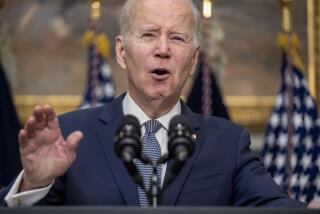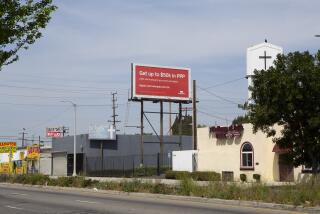Obama plans small-business lending boost
- Share via
WASHINGTON — Working to restart the economy’s engine of job creation, President Obama announced Monday that the Treasury Department would invest as much as $15 billion to boost lending to credit-hungry small businesses.
Small businesses historically have created about 70% of the economy’s new jobs, but the credit crunch has sharply reduced the volume of lending to small businesses.
“Today, too many entrepreneurs can’t access the capital to start, operate or grow their business. Too many dreams are being deferred or denied by a form letter canceling a line of credit,” Obama said after meeting at the White House with small-business owners and community bankers.
“Less lending leads to fewer jobs and lower spending, which leads to less lending -- a vicious cycle that delays our recovery,” the president added.
Under the new program, the Treasury Department would buy as much as $15 billion in loans made by banks and guaranteed by the Small Business Administration. Banks, which have been unable to sell such loans because of the credit crunch, could then turn around and make new loans.
The SBA typically guarantees $20 billion a year in loans, but that figure is on track to fall below $10 billion this year, administration and banking officials said.
Loans made after July 1, 2008, will be eligible for purchase, officials said.
“This is an incredible tool for community banks nationwide to help jump-start the economy and the credit markets,” said Cynthia Blankenship, head of the Independent Community Bankers of America, who appeared with Obama and Treasury Secretary Timothy F. Geithner as they unveiled the program.
The effort is designed in part to allay criticism that the government has focused too much on helping financial titans on Wall Street and not enough on helping Main Street.
The funding for the program will come from the government’s $700-billion financial rescue package enacted last fall.
In addition to buying loans, the administration is proceeding with plans to eliminate fees for borrowers and reduce fees for lenders in its two signature small-business lending programs and to increase temporarily the percentage of each SBA loan guaranteed by the government.
The Internal Revenue Service also released information Monday on a provision of the stimulus bill passed last month that would allow small businesses to use losses incurred in 2008 to get refunds of taxes paid on income earned as far back as 2003. Typically, such “carry-backs” can go back only two years.
Geithner called on banks to ensure that money was flowing to small businesses.
“Banks need to make the extra effort to make sure that good loans are getting to creditworthy small businesses in order to serve the larger public good of moving this nation to recovery,” the Treasury secretary said.
“And given the role that many banks played in causing this crisis, you bear a special responsibility for helping America get out of it.”
But even if banks are willing and able to lend, that doesn’t mean businesses will be lining up to borrow.
Weak demand for loans was cited Monday as a reason that lending to businesses by the biggest banks getting government rescue funds fell in January from December’s level.
Demand for commercial loans “continues to be limited by the economic downturn, as businesses remain cautious in taking on new debt obligations,” the Treasury Department said in a monthly report on lending by the 21 biggest recipients of capital from the federal government.
The volume of new business loans fell at least 41% at half of the banks surveyed.
The government said Monday that it would now require those 21 banks to provide figures each month on their lending to small businesses.
In contrast to the drop in lending to businesses, the report found, activity in residential mortgages and student loans increased in January compared with December.
--
Times wire services were used in compiling this report.
More to Read
Sign up for Essential California
The most important California stories and recommendations in your inbox every morning.
You may occasionally receive promotional content from the Los Angeles Times.










